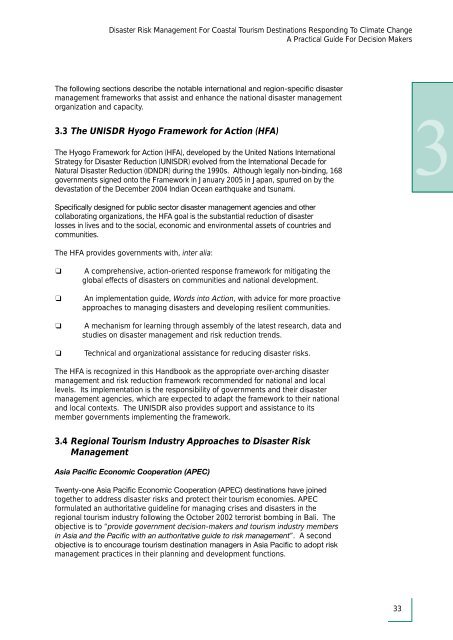Disaster Risk Management For Coastal Tourism Destinations - DTIE
Disaster Risk Management For Coastal Tourism Destinations - DTIE
Disaster Risk Management For Coastal Tourism Destinations - DTIE
You also want an ePaper? Increase the reach of your titles
YUMPU automatically turns print PDFs into web optimized ePapers that Google loves.
<strong>Disaster</strong> <strong>Risk</strong> <strong>Management</strong> <strong>For</strong> <strong>Coastal</strong> <strong>Tourism</strong> <strong>Destinations</strong> Responding To Climate Change<br />
A Practical Guide <strong>For</strong> Decision Makers<br />
<br />
management frameworks that assist and enhance the national disaster management<br />
organization and capacity.<br />
3.3 The UNISDR Hyogo Framework for Action (HFA)<br />
The Hyogo Framework for Action (HFA), developed by the United Nations International<br />
Strategy for <strong>Disaster</strong> Reduction (UNISDR) evolved from the International Decade for<br />
Natural <strong>Disaster</strong> Reduction (IDNDR) during the 1990s. Although legally non-binding, 168<br />
governments signed onto the Framework in January 2005 in Japan, spurred on by the<br />
devastation of the December 2004 Indian Ocean earthquake and tsunami.<br />
3<br />
<br />
collaborating organizations, the HFA goal is the substantial reduction of disaster<br />
losses in lives and to the social, economic and environmental assets of countries and<br />
communities.<br />
The HFA provides governments with, inter alia:<br />
<br />
<br />
<br />
<br />
A comprehensive, action-oriented response framework for mitigating the<br />
global effects of disasters on communities and national development.<br />
An implementation guide, Words into Action, with advice for more proactive<br />
approaches to managing disasters and developing resilient communities.<br />
A mechanism for learning through assembly of the latest research, data and<br />
studies on disaster management and risk reduction trends.<br />
Technical and organizational assistance for reducing disaster risks.<br />
The HFA is recognized in this Handbook as the appropriate over-arching disaster<br />
management and risk reduction framework recommended for national and local<br />
levels. Its implementation is the responsibility of governments and their disaster<br />
management agencies, which are expected to adapt the framework to their national<br />
and local contexts. The UNISDR also provides support and assistance to its<br />
member governments implementing the framework.<br />
3.4<br />
Regional <strong>Tourism</strong> Industry Approaches to <strong>Disaster</strong> <strong>Risk</strong><br />
<strong>Management</strong><br />
<br />
<br />
together to address disaster risks and protect their tourism economies. APEC<br />
formulated an authoritative guideline for managing crises and disasters in the<br />
regional tourism industry following the October 2002 terrorist bombing in Bali. The<br />
objective is to “provide government decision-makers and tourism industry members<br />
”. A second<br />
<br />
management practices in their planning and development functions.<br />
33

















